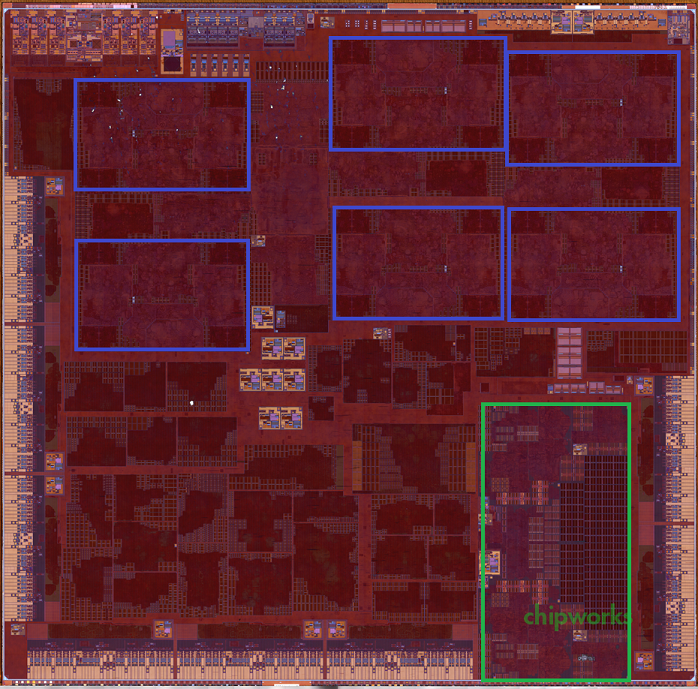Every year, the patent analysis and competitive intelligence company Chipworks tears down the applications processors found in Apple's (AAPL +1.25%) latest iPhones and iPads. As you might recall, Chipworks confirmed that the A9 processor inside of the iPhone 6s/6s was, indeed, manufactured by both TSMC (TSM +1.54%) and Samsung (NASDAQOTH: SSNLF), a fact that came as a surprise to many.
Chipworks also provided chip die sizes for both the TSMC-built and the Samsung-built A9s, giving the public a glimpse into how both chip manufacturers' respective 16-nanometer and 14-nanometer chip manufacturing technologies' compared in terms of transistor density.
After contacting the folks at Chipworks, I was able to get some interesting information about the A9X chip that powers the recently launched iPad Pro as well as a die shot of the chip that I am allowed to publish for your viewing pleasure.
Without further ado, let's get to the good stuff.
Say "hi" to the A9X
Following is a die shot of the A9X, courtesy of Chipworks:

The Apple A9X in all of its glory. Source: Chipworks, with author annotations.
Chipworks' Dick James tells me that he sees a 12-cluster GPU, two CPU cores, and an absence of the level-three cache memory found inside the A9 chip (I'll explain why I think Apple didn't include it later in this article). I agree with his assessment. The two CPU cores can be seen in the green box, and I believe that inside of each blue box are two GPU clusters, for a total of 12 clusters.
One thing worth noting is that Imagination Technologies (NASDAQOTH: IGNMF) -- Apple's GPU IP supplier -- only lists variants of its Series 7XT graphics IP with 2, 4, 6, 8, and 16 "shading clusters." The 12-cluster design points to a semi-custom implementation by Apple of the Series 7XT, similar to what Apple did with the Series 6XT-based graphics IP in last year's A8X chip.
How big is this beast?
According to Chipworks, the chip measures in at approximately 147 square millimeters, a whopping 40% larger than the size of the TSMC-built variant of the A9 chip inside of the iPhone 6s/6s Plus. This is an absolutely huge increase in area (and by extension transistor count) from the A9, which no doubt means that this monster of a chip is far more difficult to manufacture, especially on a relatively new manufacturing technology.
Connecting the lack of cache with die size
Remember how I said that it doesn't look like the A9X features the 8 megabytes of on-die cache memory that the A9 does? Well, I think I have an explanation for that.
The A9X features a memory interface that's twice as wide as the one on the A9, allowing the chip to pass data to and from memory at twice the rate that the A9 can.
I believe that this is enabled by the fact that a chip like the A9X, which powers a relatively large device such as the iPad Pro, has both more thermal headroom than the A9 (since the iPad Pro is a larger device that can handle a more power hungry chip) and can take up a larger area footprint than a phone chip (the memory inside of the iPhone 6s/6s is stacked on-top of the A9 package; the memory in the iPad Pro sits on the logic board).
Finally, note that the A9X is already a very large chip, which means that it's probably much more difficult (and expensive) to manufacture than the A9. Adding the additional level three cache may not have brought enough of a performance improvement (particularly in light of the much wider memory interface) to justify the increased chip manufacturing costs.
The A9X is a great technical achievement
I believe that the A9X is easily the most advanced mobile system-on-a-chip available today. It has best-in-class CPU/graphics performance and it is an extremely large chip built on a bleeding-edge foundry manufacturing process.
It is little wonder that the chip performs as well as it does in the various performance tests available online, and I believe that the engineering teams at Apple should be quite proud of themselves for building and deploying a chip like the A9X in 2015.
I look forward to seeing more from Apple's chip teams in the coming years; I have a feeling that investors and customers alike will continue to be impressed.
